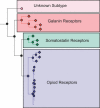Functional classification using phylogenomic inference
- PMID: 16846248
- PMCID: PMC1484587
- DOI: 10.1371/journal.pcbi.0020077
Functional classification using phylogenomic inference
Conflict of interest statement
Figures


References
-
- Eisen JA. Phylogenomics: Improving functional predictions for uncharacterized genes by evolutionary analysis. Genome Res. 1998;8:163–167. - PubMed
-
- Venter JC, Adams MD, Myers EW, Li PW, Mural RJ, et al. The sequence of the human genome. Science. 2001;291:1304–1351. - PubMed
-
- Sjölander K. Phylogenetic inference in protein superfamilies: Analysis of SH2 domains. Proc Int Conf Intell Syst Mol Biol. 1998;6:165–174. - PubMed
Publication types
MeSH terms
Substances
LinkOut - more resources
Full Text Sources

